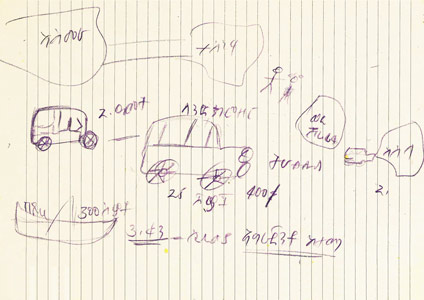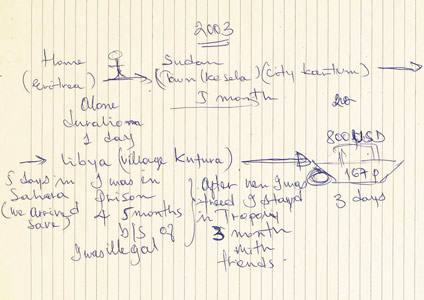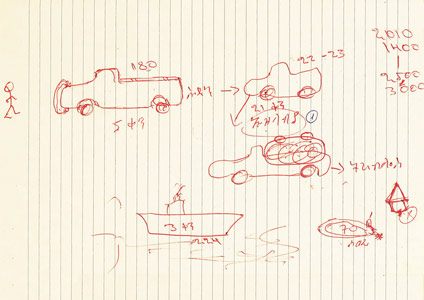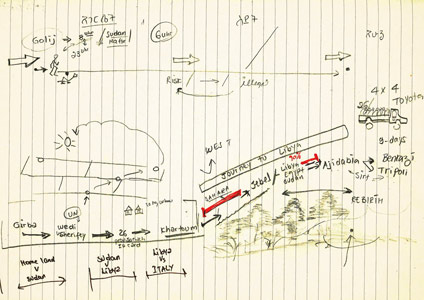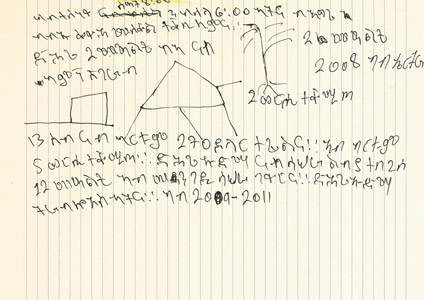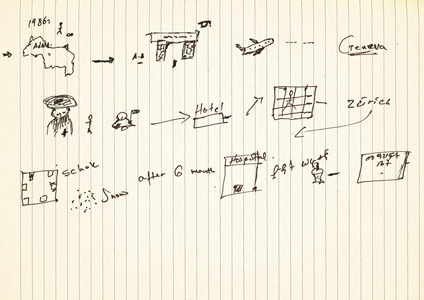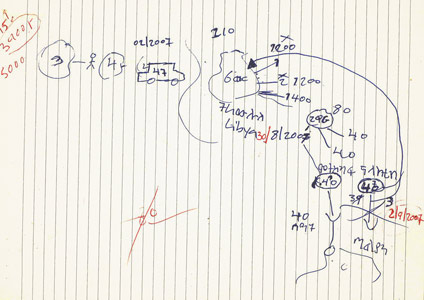Narrations of Flights
In 2013 more than 45 million people have been forced to leave their homes. This amounts to the biggest number of refugees for 14 years. Poverty, lack of economic opportunities and political persecution contribute to their decision to assume the life of a precarious migrant. Their dangerous journeys crossing several borders without legal identity exposes them to reckless human trafficking that often ends up in extortion, slavery, hunger and starvation – have rarely been documented so far. Their voice is hardly heard even though a lot is being talked and written about them. This project is a collection of sketches drawn by survivors mostly originating from the Horn of Africa who were willing to recount back their experiences.
Abraham’s flight started when the Ethio-Eritrean war broke out in 1998. He and his three brothers were recruited to fight in the war. After the war ended, he decided to leave the army and work in his profession for the sake of his family, which was struggling to have ends meet with his army salary. Initially, Abraham just overstayed his army holidays to work undercover in a construction company. But when he was caught and sentenced to six months in prison, his situation worsened. The crowded prison was badly managed and communicable diseases and diarrhea spread rapidly. He himself ended up in hospital where he became aware that the hospital was not well guarded. He managed his escape and as he was familiar with the region, he managed to reach the nearest main road. He avoided several regional checkpoints by systematically getting off before one and walking through villages and sometimes, public institutions like hospitals. Eventually, he arrived safe at his family home in Asmara without getting caught. However, he now faced more charges as a fugitive than ever before and was constantly afraid of getting caught and facing the consequences. Leaving the country for good was now his only option. Using an ID bought from a friend to cross-checkpoints, he reached the border to Sudan and from there he walked for a day until he reached the small town of Kassala. From Kessala he went to the capital Khartoum where he lived for two years working as a Tuk Tuk (Bajaj) driver. From there he and other 25 people were trafficked to Tripoli where he eventually joined a small boat packed with an estimated 300 people ready to sail off to Sicily, Italy. The boat reached its destination safely after three days.
Esaysa was one of the lucky ones that managed to have a relatively low-risk journey to Europe. He left Eritrea in 2003 assisted by a paid guide. It took them one day to walk to the small town of Kassala (Sudan). From Kassala he went alone to Khartoum, the capital city of Sudan, where he stayed for 5 months. From Khartoum he and several others crossed the Sahara in order to reach Kufrah in Libya. It took them five days to arrive there without any incidents. However after their arrival, the Libyan boarder police seized them. Deemed illegal, they were put in prison. They spent five months in prison without charge and were eventually released without further explanation. After his release, he went to Tripoli where he stayed with friends for three months while looking for the next boat to cross the Mediterranean to Italy. After paying 800 US dollars for a space in a small boat, he crossed the Mediterranean along with other 167 people. They reached Italy after three days on sea.
Daniel exodus from Eritrea began after having been imprisoned, interrogated and toured for allegedly assisting soldiers desert the army. An allegation he strongly denies. After his release from prison, he decided to leave the country. After reaching the Sudanese border on foot, he continued travelling using various forms of transportation until he reached the capital city Khartoum. After a year of waiting and laboring in Khartoum, he managed to buy a space in a lorry packed with 180 people, destined for Libya. The trip through the Sahara was long and hazardous but the group managed intact. After reaching Libyan territory, it was dangerous to smuggle 180 people all at at once. Hence, to reduce the chance of being caught, a pickup (shown on his sketch) was used to transport only 22-23 people at a time to Ajdabia (704.85 Km east of the capital Tripoli). It took 21 days to transport all 180 during which they rest were left in the desert. The pickup with Daniel on board tumbled when the wheel was stuck in a sand dune. One boy lost his life and several others got seriously injured. Yet, Daniel survived with only minor bruises. Ones in Adjdabia, he had to endure another month in a hidden camp before being smuggled in a gas container to Tripoli. In Tripoli he was put in a small house run by traffickers. Daniel had to pay the fee of 1500 USD to stay in the increasingly crowded house with no sufficient food, sanitation or water. The daily meals consisted of boiled rice and nothing else. Finally the day arrived to board a boat that sees him across the Mediterranean together with other 223 people. The smugglers used the same technique they used in the Sahara to avoid getting caught by the Police. They transported fewer people via a small inflatable boat to the bigger boat waiting offshore. Lucky enough, the boat made it to Italy with out any loses of causalities. According to Daniel, the trafficking price has now increased. While upfront payment was 1500 USD in 2010, it is now 2500-3000 USD. (This account was written in 2013 before the current Libyan war started)
Melaku lived in the Eritrean border town of Golij (approximately around 20 km away from the Sudanese border). He decided to eventually leave his country because the salary he received as a teacher was not sufficient to sustain his family. Without really caring for proper equipment, apart from some savings, he started his trip in the night when its cooler. His intentions were to follow the direction of sun set. After all how hard can that be? But the journey turned out to be more demanding than he expected when the farmlands in between the two borders got increasingly parceled and fenced with thorny bushes that are difficult to cross. While trying to avoid these thorny fences, he lost orientation. Assured by his proximity to Sudan, Melaku was not properly equipped with enough water or food incase things go wrong, like they did. A journey he thought will take only a couple of hours in the cool night took more than 8 and he found himself walking back to Eritrea by dawn. By now afraid of being caught, utterly exhausted and dehydrated, he started running west. The sun brought the desert heat full on and when he was sure about dying from dehydration, he spotted a small oasis. Not sure if he was hallucinating or not he started walking in that direction until he was close enough to see some camels resting. The last thing he remembers is walking towards the group of merchants gathering around an afternoon tea and collapsing in front of them. They turned out to be illegal contraband merchants and were alarmed by his sudden appearance. But once they saw that he was not a Sudanese soldier they assisted him. He received water and tea, and one of them eventually decided to bring him to the next refugee camp in return for a payment. Melaku then spent many months traveling from one refugee camp to another eventually reaching Tripoli and finally arriving via Italy in Switzerland.
Netsanet started her journey from the town Teseny in Eritrea with her one-year-old son in order to reunite with her husband who was at that time waiting for them in Tripoli, Libya. A smuggler guided them to the border town of Kassala where a refugee camp is located. After having spent two nights under a tree next to the registry office, she was finally registered as a refugee by the Red Cross. Subsequently she was transferred to the refugee camp of Shegerab in Sudan. Prior to joining twelve other people that were heading west towards Khartoum, she lived for two months in a tent with her toddler. This trip coasted 270 USD. She stayed in Khartoum for 5 months before deciding to start the precarious ride across the Sahara with her son. The trip was not easy and it took them12 days to cross the desert. They finally arrived in the capital Tripoli where Netsanet‘s husband was waiting eagerly to finally be reunited with his family again. The family lived in Tripoli for two years, trying to find several ways to cross to Europe with no result. On the second month of 2011, her husband boarded a smuggling boat across Mediterranean. Unfortunately, he and everyone else on the boat did not make it to Italy. The boat sank along with its passengers. Netsanet was left without a husband and a fatherless child in a foreign country. She eventually went to Tunisia where she lived in a refugee camp. Ultimately, she and her child were granted resident permits by Switzerland with the help of her brother who was already a Swiss resident.
Michael was born in 1967 and raised in Adwa, North Ethiopia. His family however poor and struggling knew the importance of education and tried their best to educate their children. As a child he walked 3 kilometers on foot everyday to school. He passed his higher education entrance exam with an excellent result and he joined the school of law in Addis Abeba University. When he was a 4th year student, a clash broke out between students and the communist regime, the government at that time. That put his education to a halt and his life in danger. In that time young men were being hunted for their political views , Michael’s family got increasingly scared for their oldest son’s life and decided to send him abroad in any way possible. The family paid a substantial amount of money to a smuggler that would eventually bring Michael to Geneva with the false pretense of being the Pope’s journalist. On his arrival in Geneva, Michael was seized and put in prison until his case was cleared and he was accepted as a political refugee in Switzerland. Just when he thought he is safe and his life would change for the better, problems of integration started to unfold. He was shocked to see his first snow and broke down and cried when he first started his job as a janitor in a public library. But luckily, the manager of the library found him reading a book by Sigmund Freud on one of his breaks and she asked him if he understood the book, saddened by her question he told her his story and that it was a book he wanted to read for so long but couldn’t find it in Ethiopia when he was a student. Very touched, the manager gave him a position in the kitchen and also organized him a better living place. Grateful for his new position and opportunity he made it his duty to learn about cooking and how it is like to run a business. One thing led to another and he currently owns and manages his own successful restaurant that serves Ethiopian and Eritrean cuisines in collaboration with a friend.
Aman was only fifteen years old when conscripted to join the Eritrean army training camp SAWA. By coincidence he found himself stationed with a group of seven that were planning to desert the army. The idea excited the 15 years old Aman and he join them on the dangerous endeavor. After only three months of training in the army, he escaped with the rest of the group to Sudan, Khartoum. The fact that the government exercises a “Shoot to kill” policy in regard to those caught deserting the military service or the country, did not alter his decision. It took the group four days to reach Khartoum. They stayed there for six months until they joined a larger group that was being smuggled to Kufra in Libya (1360 km from Tripoli). All together, they were 47 individuals in a single minivan. From Kufra they were eventually transported to Tripoli, the capital. In Tripoli, Aman and his colleagues spent six months in a camp run by traffickers. Once the traffickers, who organized accommodation and transport in return for payments, found the camp sufficiently packed, they prepared for a trip across the Mediterranean that would bring the refugees from Tripoli to the Italian island of Sicily. Aman and his friends had to pay 1400 USD each (an amount his family paid) to a smuggler who claimed to have prepared a ship ready to board for 110 people. However, that turned out to be a scam and the man disappeared with their money without further notice. Eventually after being forced to pay the same amount again, a total of 80 people including Aman and his friends were offered to embark on two inflatable plastic boats (40 persons on each boat). During the hectic departure, Aman was separated from his group that was aboard the second boat. The dangerous journey took 40 hours with only a GPS tracker to guide them. Aman’s boat reached his destination safely only to learn about the shipwreck of the other inflatable boat. 39 of its passengers including his friends were lost at sea on September 2, 2007.
Nigist Goytom in conversation with and drawings by
Abraham, Esayas, Daniel, Melaku, Netsanet, Michael and Aman
in Zurich, 2013/2014
Narrations of Flights
RELATED WEB SITE
→ artist’s website
[ CITRACIT ]
[ I am home ]
• Narrations of Flights •
[ Oblique ]
[ Palestinian Dictionary ]
[ Pilgrimages ]
[ Post Mortem ]
[ Sound Tracking ]
[ The Hours that Hold the Form (A Couple of Days in Portbou) ]
[ The Tongued Tongues ]
FEATURED THEME ON CITY SHARING
by ASUNCION MOLINOS GORDO
-
This project is an instrument for common critical analysis to help understand the reasons behind Egyptians’ diminishing …
by INAS HALABI
-
The project Letters to Fritz and Paul focuses on the expeditions of the Swiss cousins, lovers and scientists, Fritz and …
by SARAH BURGER
-
The planned modern city of Brasilia attracted me since a long time. Her defined shape, location and function proceded he …
by ADRIEN GUILLET
-
Youri Telliug talks with the artist Adrien Guillet about his project Citracit
Youri Telliug - What is Citracit …
by NIGIST GOYTOM
-
In 2013 more than 45 million people have been forced to leave their homes. This amounts to the biggest number of refugees …
by SULAFA HIJAZI
-
The on going debate on Arab identity and its (cultural) representation is strongly shaped by Edward Saidʼs formative …
by ASUNCION MOLINOS GORDO
-
WAM is a site-specific work that uses the historical trope of the cabinet of curiosities to explore the introduction of …
MORE CONTRIBUTIONS BY THE FOLLOWING
